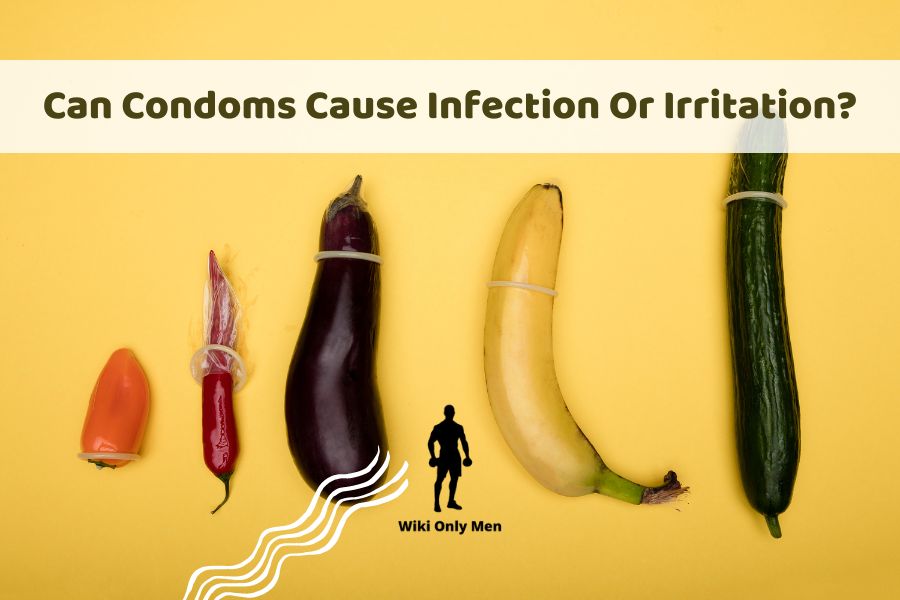Condoms are one of the most widely used forms of contraception and are an essential tool in preventing sexually transmitted infections (STIs). They provide a physical barrier between partners, which helps to reduce the risk of transmitting STIs during sexual contact.
But, Can Condoms Cause Infection Or Irritation? Yes, there are instances when condoms can cause infection or irritation. It is crucial to understand the factors contributing to these potential side effects and how to minimize the risks.
Contents
What Are Condoms?
Condoms are thin, stretchy sheaths made of latex, polyurethane, or other materials. They are designed to fit over an erect penis and prevent the exchange of bodily fluids during sexual contact.
Condoms come in various sizes and types, including male and female condoms. Male condoms are the most commonly used type and are made to fit over a man’s penis. Female condoms are worn inside the vagina and provide similar protection against STIs.
Condoms And Infections

Condoms can help reduce the risk of STIs, but they are not 100% effective. In rare cases, condoms can break or slip off, increasing the risk of transmission. However, the correct and consistent use of condoms can significantly reduce the risk of STIs. The most common STIs transmitted through sexual contact include chlamydia, gonorrhea, syphilis, and human papillomavirus (HPV).
Condoms And Irritation
In addition to the potential for infection, condoms can also cause irritation. This can occur during or after sexual contact and manifest as itching, redness, burning, or soreness. Common causes of condom-related irritation include an allergy to latex or lubricant, improper use of the condom, and using a condom that is too small or too large.
To minimize the risk of condom-related irritation, it is important to choose a condom that fits correctly and to use a lubricant if necessary.
In these cases, switching to a different type of condom (such as polyurethane) can help to minimize the risk of irritation.
If you experience any symptoms of irritation after sexual contact, it is crucial to seek medical attention as soon as possible. Your healthcare provider can help diagnose the cause of the irritation and recommend the appropriate treatment.
In the later parts of this article, we’ll learn how to fight a condom allergy.
Causes Of Condom Allergy
Condom allergies can be caused by several factors, including the natural rubber latex material used in most condoms and proteins in the latex, which the immune system may mistake as harmful.
The presence of spermicide or lubricants in condoms can also lead to allergies, causing bacteria to overgrow and leading to infections.
Additionally, a 2002 study found that people with a latex allergy are more likely to be allergic to certain plant-based foods, such as avocados, bananas, chestnuts, and more, due to similar proteins present in these foods.
What Signs Point To A Condom Allergy?
Both local and systemic symptoms may be brought on by condom allergy. Local symptoms, such as hives, blisters, itching, redness, and skin swelling, only manifest in areas of the skin that have come into direct contact with the condom.
Symptoms like those linked to systemic allergies are more likely to be more severe in those with sensitive skin. Because the mucous membrane in the vagina absorbs latex protein more quickly than the membrane on the male penis, this type of allergy is more prevalent in women.
Hives and swelling in areas not in contact with condoms, as well as runny or stuffy nose, watery eyes, sore throat, and face flushing, are signs of a systemic allergy.
In severe cases, a condom allergy can even lead to anaphylaxis, a life-threatening allergic reaction characterized by difficulty breathing, difficulty swallowing, and swelling in the mouth, throat, or face. If you experience these symptoms, it is crucial to seek medical attention immediately.
Are Condom Allergies Common?
Condom allergies are relatively rare, affecting only about 1% of the population. However, frequent exposure to latex, the material used in most mainstream condoms, can increase the risk of developing an allergy.
While a latex allergy can cause discomfort and health concerns, it should not prevent individuals from practicing safe sex. Alternative options, such as polyurethane condoms, are available and provide effective protection against pregnancy and sexually transmitted infections.
How To Handle A Condom Allergy

Condoms are an essential tool in protecting against pregnancy and sexually transmitted infections. However, for some individuals, the use of condoms can also be a source of discomfort and health concerns. One such concern is a latex allergy or sensitivity.
However, frequent exposure to latex can increase the risk of developing an allergy. The symptoms of a latex allergy or sensitivity can range from mild to severe, including itching, burning, and rashes that may appear several hours after intercourse.
For women, using latex condoms can also exacerbate urinary tract infections and yeast infections. Although a latex allergy cannot directly cause an infection, it is vital for women who experience recurrent infections to be tested for an allergy.
Despite the potential for discomfort or health concerns, it is crucial to continue practicing safe sex. The threat of sexually transmitted diseases such as HIV is too significant to ignore.
For individuals with a latex allergy or sensitivity, alternative options for protection are available. These include polyurethane and animal-skin condoms.
Polyurethane condoms provide the same level of protection against pregnancy and sexually transmitted infections as latex condoms, making them a suitable option for those with a latex allergy or sensitivity. However, it is important to note that animal-skin condoms do not provide the same level of protection and should not be relied upon as the sole means of protection.
If you are unsure whether you have a latex allergy or sensitivity, it is essential to seek medical advice and undergo testing. This will ensure you have the correct information and tools to handle your condom allergy effectively and continue practicing safe sex.
When Should I See A Doctor?
If allergy symptoms last longer than one to two days or an allergy is still caused by alternative condoms, consult a doctor. The doctor will do a physical examination and order diagnostic testing to rule out STIs and bacterial infections, which can also manifest similarly symptomatic conditions.
Antibiotics can usually treat most genital infections, but if they are not, they can have serious side effects, such as infertility. See a doctor for a thorough diagnosis and effective treatment of any underlying disorders.
Conclusion
Condoms are essential in preventing STIs but can also cause infection or irritation. Understanding the factors that contribute to these potential side effects and knowing how to minimize the risks can help you make informed decisions about your sexual health.
If you experience any symptoms of infection or irritation after sexual contact, it is crucial to seek medical attention as soon as possible. By taking the necessary precautions, you can enjoy a healthy and fulfilling sex life.

